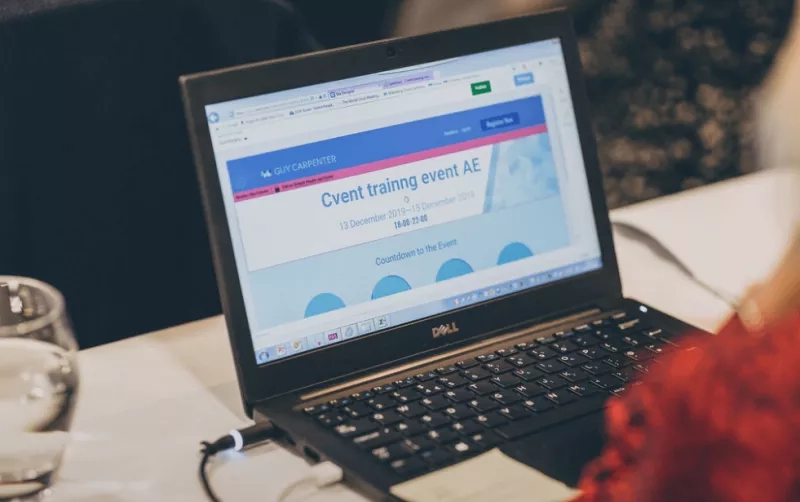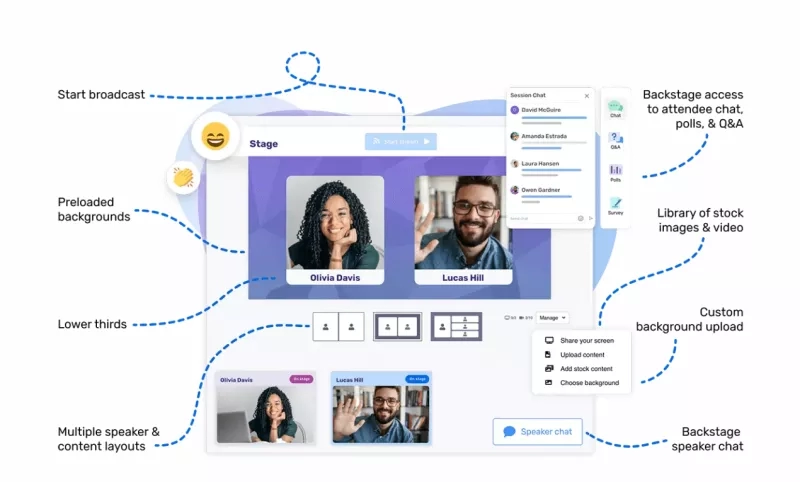The days of snooze-worthy meetings are over. Modern webinar platforms provide a fresh alternative for hosting engaging online events. In this post, we'll explore the benefits of creating engaging webinars and provide tips to help you host webinars that wow and inspire your audiences.
What is a Webinar Meeting?
A webinar is an online meeting hosted by an individual, company, or organization and broadcasts to attendees through their computers and mobile devices via the Internet. Webinars are interactive, with the ability to give, receive, and discuss information in real time.
Unlike a traditional in-person seminar, a webinar allows participants from around the globe to join in, eliminating geographical constraints and opening up opportunities for widespread engagement and learning. Attendees can ask questions, respond to polls, and interact with the host and other participants.
Webinars serve various purposes: education, marketing, training, and product demos. They can also be recorded and shared later for people who couldn't attend the live session, allowing for additional reach and engagement beyond the initial live event.
Webinar Meetings vs. In-Person Meetings
Webinars provide some distinct advantages and differences from in-person meetings:
| Webinar Meetings | In-Person Meetings |
| Increased reach and accessibility | Limited to local geographic attendees |
| Lower cost with no travel or venue expenses | Higher price for travel, food, venue, equipment |
| The convenience of joining remotely on your device | Time required for commuting and travel |
| Ability to record and reuse content | Harder to capture and reuse content |
| Easy to automate and scale webinars | Manual effort is required to arrange details. |
| Data and analytics on engagement | Harder to track attendee behavior |
| Less personal connections and interactions | More personal connections between attendees |
| Can lack energy without the in-person presence | Shared energy from live interactions |
| Technical glitches can disrupt events. | Unlikely to have tech issues disrupt the event |
Ultimately, webinars are better for reaching larger audiences, reducing costs, and leveraging recordings and automation. In-person meetings build closer connections and energy between local participants. Your chosen format depends on your goals, target audience, and budget for each event.
Benefits of Hosting a Webinar Meeting
There are many benefits of hosting webinars. For instance, most marketers feel that webinars outperform other marketing channels to create qualified leads and reduce cost per lead. Here are a few other advantages:
- Increased reach and accessibility: Webinars allow you to easily include participants from anywhere with an internet connection, eliminating geographical barriers. This increases the potential reach and audience size for your events.
- Cost savings: Webinars provide significant cost savings over in-person events. They eliminate travel costs for presenters and attendees, as there is no need to rent event space or equipment.
- Convenience and flexibility: Webinars allow attendees to join from their own space on their devices, increasing convenience. Presenters also have flexibility in choosing a location to present from.
- Ability to record and reuse content: Most webinar platforms allow you to record sessions to share or reuse later. This creates an asset you can continue leveraging over time.
- Easy sharing and promotion: Webinar registration and attendance only require a link, making it easy to widely share and promote your webinar through email, social media, and other digital channels.
- Analytics and measurability: Webinar platforms provide data like registration, attendance, engagement, and rewatch rates, allowing you to analyze and optimize your events closely.
How To Host a Webinar Meeting?
Hosting a successful webinar requires the right tools, planning, and execution. Here are a few things to consider when hosting a webinar:
- Choose A Webinar Platform
Different webinar software solutions have different features, capacities, and pricing. Consider how many attendees you expect, whether you need additional engagement features, and your budget.
- Plan Your Content
An engaging presentation is the cornerstone of a successful webinar. Ensure your content aligns with your stated webinar objectives and offers value to your attendees.
For instance, if you're conducting a webinar on the topic "Latest Trends in Digital Marketing," ensure that your presentation encompasses current strategies, case studies, and future predictions in the digital marketing realm. Visual elements, like infographics, videos, and slides, can enhance comprehension and engagement.
- Promote and Market Your Webinar
Your webinar marketing strategy can make or break your event’s attendance. Use a multi-channel approach to reach your target audience. For example, you can use your company's newsletter to contact your email subscriber base, social media platforms like LinkedIn and Twitter for broader outreach, and search-engine-optimized blog posts on your website. Remember to send reminders to registered people and offer incentives such as free e-books or exclusive content to increase registrations.
- Set up and Test Technical Elements
Technical glitches can disrupt the flow of your webinar and impact the attendee experience negatively. Ensure you use a reliable and experienced company when choosing your webinar platform.
- Engage with Interactive Elements
Interactive elements maintainattendee engagement and foster a two-way communication channel. For example, you can schedule a live Q&A session during the last 15 minutes of the webinar, utilize the polling feature to gather instant feedback, and encourage audience interaction via the chat function. Engaging your audience in this manner makes them feel part of the conversation rather than passive spectators.
- Follow Up with Recordings and Resources
After the webinar, send out a follow-up email with the recording, the presentation slides, and any additional resources promised during the webinar. This allows attendees to review the material at leisure and ensures that those who registered but couldn't attend still receive the information.
Sending a survey after the webinar can provide valuable feedback to improve future webinars. Here are some sample post-webinar survey questions:
- On a scale of 1-5, how would you rate the overall webinar experience?
- What did you find most valuable about the webinar?
- What suggestions do you have for improving the webinar content?
- Was the length of the webinar appropriate? Too long or too short?
- How engaging and interesting was the presenter's delivery style?
- Were the visuals, slides, and materials helpful?
- Did you experience any technical difficulties joining or participating?
- How likely are you to attend another webinar from us?
- What topics would you be interested in for future webinars?
- How did you hear about this webinar?
Sending a quick satisfaction survey immediately after a webinar wraps up while it's fresh will get the most helpful feedback to iterate on for your next online event.
Related: Ultimate Webinar Checklist for 2023.
Webinar Attendee Engagement Tips
Keeping your attendees engaged during a webinar can be challenging without in-person energy. Here are some webinar best practices for driving webinar attendee engagement:
- Start strong: Like in a movie or a book, the opening scene sets the tone for the rest of the story. The same concept applies to webinars. Opening your webinar with a captivating story, a surprising statistic, or a thought-provoking question will instantly grab your audience's attention.
For example, if your webinar is about data security, start with a recent news story about a significant data breach to highlight the relevance and importance of your topic.
- Talk conversationally: Connecting with your audience personally is crucial for engagement. Instead of presenting in a formal or lecture-like style, adopt a more conversational tone. Use the word "you" to create a more inclusive atmosphere and make attendees feel like you're speaking directly to them.
- Vary your pace and tone: A monotone voice or a constant rapid-fire pace can lead to a disengaged audience. To prevent this, vary your speaking pace, use pauses for emphasis, incorporate humor, and tell relevant stories. This variety in your delivery keeps the content fresh and engaging.
- Leverage visuals: Visual elements play a crucial role in breaking up the monotony and enhancing understanding of complex topics. Rather than just speaking into the camera, incorporate slides, videos, screenshots, or live demos.
For instance, if you're discussing a new software tool, a live demo can help attendees visualize its functions and benefits better.
- Engage with polls and Q&A: Real-time polling questions and Q&A sessions can significantly increase attendee involvement. They give attendees a chance to voice their thoughts and queries and provide you with immediate feedback. For example, if you're conducting a webinar on digital marketing trends, a quick poll about which trend attendees find most interesting can make the webinar more interactive.
- Moderate chat: Assigning a team member to moderate and respond to chat questions in real time can make the webinar feel more interactive. It ensures that attendee questions and comments don't go unnoticed and helps maintain the momentum of the webinar.
- Gamify with prizes or giveaways: Everyone loves a competition. Offering rewards or giveaways for participating in polls, quizzes, or discussions can motivate attendees to engage more actively. For instance, you could provide a free e-book or discount codes to the first three attendees who answer a quiz correctly.
- Limit presentation length: Keep your presentations concise to avoid fatigue. Aim for a session of around 30-45 minutes, followed by a Q&A period. This approach respects attendees' time while allowing room for discussion and queries.
- Check-in on attention: Periodically, you can check your audience's attention with quick questions or prompts. Something as simple as "Give me a 'yes' in the chat box if you're following along" can help you assess the audience's engagement level and allow attendees to indicate they are active and attentive.
Must-have Features of Webinar Platforms
Whether aiming to educate, inform, or inspire, the right platform can make all the difference. But what makes a webinar platform stand out? Let's dive deeper into the must-have features that can turn any virtual event into an engaging and memorable experience:
- High-definition video and audio capabilities: Crystal-clear video and crisp audio form the foundation of a practical webinar. The platform must deliver high-definition quality to ensure seamless communication and engage attendees.
- Live chat functionality: The ability for participants to communicate in real-time via live chat boosts interactivity, encouraging questions, feedback, and discussion during the webinar.
- User-friendly registration and scheduling: An intuitive interface for scheduling webinars and managing participant registrations simplifies planning. Automated reminders can also help to increase attendance rates.
- Customizable branding: The ability to customize the platform's appearance according to your organization's branding gives your webinars a professional look and feel. This reinforces your brand identity and creates a consistent experience for attendees.
- Analytics capabilities: Post-webinar analytics can provide valuable insights into attendee behavior, such as the duration of attendance, engagement level, and more. This data is crucial for understanding the effectiveness of your webinars and identifying areas for improvement.
- Robust security features: Given the sensitive information often shared during webinars, security features like data encryption and secure login methods are essential. These measures ensure the privacy and safety of all participants and their data.
Final Thoughts
Virtual meetings are here to stay. Webinar technology provides the bridge to get there. While in-person gatherings are the go-to choice for fostering local connections, webinars are a powerful choice for engaging global audiences--from anywhere.
With the strategies and best practices covered in this post, you have an actionable blueprint for hosting remarkable webinars that drive impact. Remember, every webinar is a learning experience, so don't be afraid to experiment, ask for feedback, and continually refine your approach. Happy webinar hosting!









